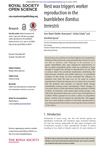| dc.contributor.author | Rottler-Hoermann, Ann-Marie | en_US |
| dc.contributor.author | Schulz, Stefan | en_US |
| dc.contributor.author | Ayasse, Manfred | en_US |
| dc.date.accessioned | 2016-10-11T05:37:27Z | |
| dc.date.available | 2016-10-11T05:37:27Z | |
| dc.date.issued | 2016 | en_US |
| dc.identifier.other | HPU4160697 | en_US |
| dc.identifier.uri | https://lib.hpu.edu.vn/handle/123456789/23590 | |
| dc.description.abstract | Social insects are well known for their high level of cooperation. Workers of the primitively eusocial bumblebeeBombus terrestris are able to produce male offspring in the presence of a queen. Nonetheless, they only compete for reproduction, in the so-called competition phase, when the workforce is large enough to support the rearing of reproductives. So far, little is known about the proximate mechanisms underlying the shift between altruism and selfish behaviour in bumblebee workers. In this study, we have examined the influence of chemical cues from the nest wax on the onset of worker reproduction. | en_US |
| dc.format.extent | 16 p. | en_US |
| dc.format.mimetype | application/pdf | |
| dc.language.iso | en | en_US |
| dc.subject | Biology | en_US |
| dc.subject | Chemical ecology | en_US |
| dc.subject | Conflict over male production | en_US |
| dc.subject | Cuticular lipid | en_US |
| dc.subject | Nest environment | en_US |
| dc.subject | Social insect | en_US |
| dc.subject | Wax scent | en_US |
| dc.title | Nest wax triggers worker reproduction in the bumblebee Bombus terrestris | en_US |
| dc.type | Article | en_US |
| dc.size | 612KB | en_US |
| dc.department | Education | en_US |

